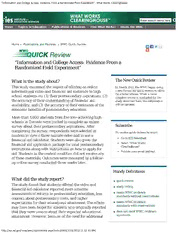
ERIC ED539900: What Works Clearinghouse Quick Review: "Information and College Access: Evidence from a Randomized Field Experiment" PDF
Preview ERIC ED539900: What Works Clearinghouse Quick Review: "Information and College Access: Evidence from a Randomized Field Experiment"
“Information and College Access: Evidence From a Randomized Field Experiment”: What Works Clearinghouse Home Topics in Education Publications & Reviews Find What Works! Inside the WWC News & Events About Us Home > Publications and Reviews > WWC Quick Review “Information and College Access: Evidence From a Randomized Field Experiment” The New Quick Review What is the study about? This study examined the impact of offering an online In March 2012, the WWC began using informational video and financial aid materials to high a new format for quick reviews to allow for a faster release. When a more school students on: (1) their postsecondary aspirations, (2) complete review is conducted for the the accuracy of their understanding of financial aid study described here, this information availability, and (3) the accuracy of their estimates of the will be updated. economic benefits of postsecondary education. More than 1,600 students from five low-achieving high schools in Toronto were invited to complete an online Subscribe survey about their postsecondary aspirations. After completing the survey, respondents were selected at To receive quick reviews by email: random to view a three-minute video and to use a Go to IES Newsflash financial aid calculator. Students were also given the Select “What Works financial aid application package for local postsecondary Clearinghouse” institutions along with instructions on how to apply for Provide your email address aid. Students in the control condition did not receive any of these materials. Outcomes were measured by a follow- up online survey conducted three weeks later. Handy Definitions What did the study report? quick review The study found that students offered the video and study rating financial aid calculator reported more accurate meets WWC evidence assessments of returns to postsecondary education, less standards without reservations concern about postsecondary costs, and higher expectations for their educational attainment. The effects meets WWC evidence standards with reservations may have been larger for students who originally reported that they were unsure about their expected educational does not meet WWC evidence standards attainment. However, because of the need for additional http://ies.ed.gov/ncee/wwc/quickreview.aspx?sid=20001[2/25/2013 11:52:43 AM] “Information and College Access: Evidence From a Randomized Field Experiment”: What Works Clearinghouse data from the study authors, the What Works Clearinghouse (WWC) cannot confirm the statistical See the full glossary significance of any of the study’s outcomes. How does the WWC rate this study? The study is a randomized experiment. Although overall attrition was 40%, attrition rates differed by only one percentage point in the treatment and comparison groups. Therefore, this study could potentially meet WWC evidence standards without reservations. A more thorough review (forthcoming) will be conducted to determine the study rating. Citation Oreopoulos, P., & Dunn, R. (2012). Information and college access: Evidence from a randomized field experiment (Working Paper No. 18551). Retrieved from http://www.nber.org/papers/w18551. Posted: January 2013 This quick review was prepared by Development Services Group, Inc. for the WWC under contract ED–IES–12–C–0084. Institute of Education Sciences News & Events | Contact Us | Help | RSS | Privacy Policy U.S. Department of Education What Works Clearinghouse Statistical Standards | FedStats.gov Notice of Language Assistance: English | español | ��: ��� | Việt-ngữ | ��� | Tagalog | Русский http://ies.ed.gov/ncee/wwc/quickreview.aspx?sid=20001[2/25/2013 11:52:43 AM]
